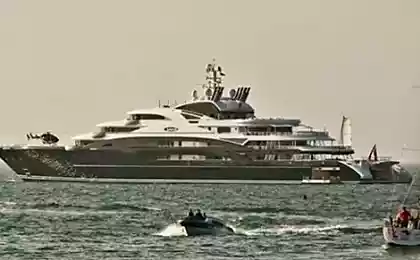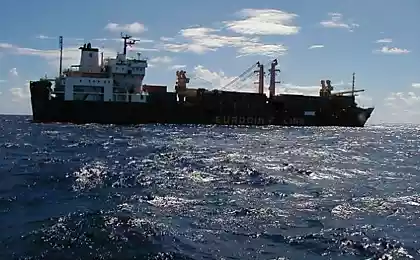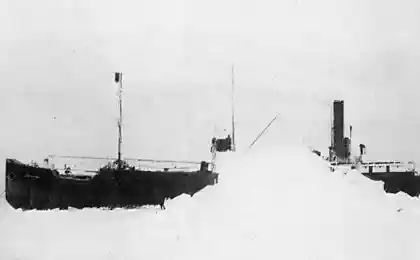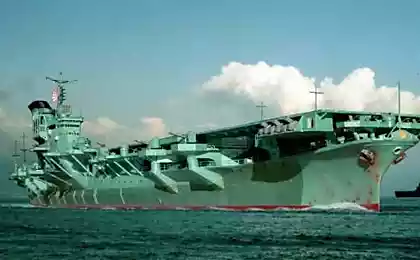1747
Imperial yacht
The only boat that participated in the fighting and in the sunken wreck, the Black Sea was wheeled imperial "Livadia».
Its construction began in late 1869, but the official laying of the ship took place March 19, 1870.
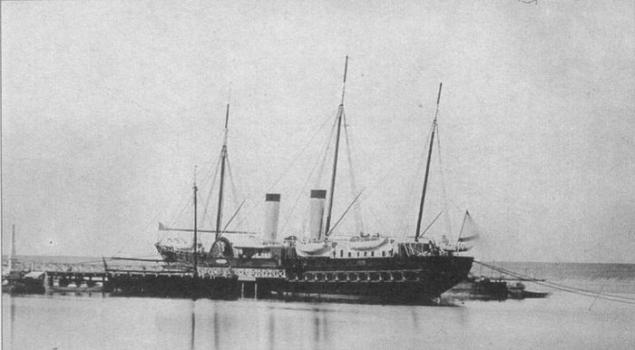
Design and build a boat the famous Black Sea naval captain of the Corps of Naval Architects LG Swedes, for completion by the summer of 1873. The new 4-wheel gun wooden boat on the king of comfort and decoration of the premises it is not inferior to the Baltic "Power", and on registration "royal cabin" in the stern of the boat, and the dining room on the middle deck, the implementation of the project of architect Monighetti even superior to the latter. In the course of construction "Livadia" LG Schwede in 1872 he performed the alleged figure figurehead yachts in the form of a convex oval shield with the double-headed eagle "Livadia" received a figurehead in the form of a two-headed eagle, crowned, like set to "Power".
In the summer of 1873 a new boat, entering the Black Sea Fleet, arrived in Sevastopol, where the empress brought to Yalta with his family. In March 1874 "Livadia" went to practice diving. In the western part of the Mediterranean yacht successfully withstood an 11-point storm, showing excellent seaworthiness. It should be noted that the "Livadia" - the only one of the imperial yacht, participated in combat operations of the Russian fleet. During the Russian-Turkish war of 1877-1878 under the command of Captain 1st Rank FE Krouna it cruising the Romanian and Bulgarian coast and 21 August sank two-masted Turkish kochermu. Noted two Turkish armored ships, yacht sustained 18-hour chase and successfully went under the protection of Sevastopol batteries. The three-year service "Livadia" ended tragically. On the way from Sevastopol to Odessa it is foggy night from 21 to 22 October 1878 jumped to the reef at Tar-hankutskogo lighthouse on the west coast of the Crimea. 47 days, from October 22 to December 7, "Livadia" standing on a rock. After a series of unsuccessful attempts to save the Black Sea Fleet command ship, everything of value that was possible, had been brought to shore, leaving the body waves of the sea.
It was supposed to build a new, similar victims, increasing its speed and cruising range, but Vice-Admiral AA Popov, at that time, and became chairman of the MTC, he proposed another option. According to the instructions of EE Gulyaev drafted a yacht, having regard to the shape of an ellipse on the basis of Novgorod. Considering this form the starting point for selecting the type of the future of the Black Sea battleship, Andrey decided on a full-scale experiment. It is understood by those skilled not only in Russia but also in England. Thus, the "Times" in 1879 wrote: "... the stability and comfort are the main qualities that were pursued in the design of the yacht, and if the maximum stability is provided in the form of the famous yacht, the addition of armor and possible changes can make it on the basis of the same principle, not less stable artillery platforms. It is no secret that the new yacht has experience ... ».
In addition to providing stability, comfort and safety of navigation, the main attention was paid to the design of the achievement of a new vessel speed of 14 knots. According to the results of tests on Vice Admiral Popov in the Black Sea and the model tests in England to identify the main dimensions of the future yachts with draft 1, 9 m, satisfying all the requirements proposed. To check the data, and at the request of designers and builders of the future, paraffin models her body underwent at the beginning of 1879 a new test in Amsterdam under the guidance of Tiedemann. This very well-known shipbuilder and the chief engineer of the Dutch navy confirmed the conclusions of the Froude and guarantee the achievement of a vessel speed of 14 kt, when the power of the power plant more than 8,500 liters. from. (project capacity was assumed to be l 10000-11000. sec.). The general location of the royal screw yacht "Livadia»

At mid-year, as agreed with the British shipbuilding company "John Elder and K °», the project finalization. In August, after a written statement of the main builder of the firm Pierce the possible establishment of such a vessel, followed by a private resolution of Alexander II to build a new yacht in England. September 5 Pier and the famous Russian figure shipbuilding MI Qazi signed. The terms of this document was not very common. Their essence was to shipbuilders obligation not only to build itself on the Russian ship's drawings, with the installation of its own production of steam mechanisms, but also the guarantee of achieving boat speed of 15 knots. For each undeveloped 0, 1 assembly firm paid heavy fines, and in the case if the ship goes at a speed less than 14 kt., The customer has the right to do, it does not take, and pick up only power plant, for which, and pledged to make the contractual payments in the buildings. If successful, the test calculation of the yacht followed after her surrender. For exceeding speed limits (15 kt.) And capacity (12,000 liters. With.) Builders received substantial bonuses. The latter condition was to encourage firms to create and perfect power plants, intended not only for yachts, but also, if successful, for future Russian ships and the battleship Peter the Great, the machine is, as well, and have a series of Novgorod did not develop capacity. < br />
The period of construction was in English is short: until 1 July next, 1880 Furthermore, during a personal audience with the Grand Duke Konstantin Nikolayevich after signing the contract, Pierce offered early surrender yacht! The work at the shipyard, located in Ferrol (on the River Clyde, on the outskirts of Glasgow), began immediately after the signing of the documents. Appointed oversaw the construction, the author of EE Gulyaev a month later reported on the manufacture of templates for metal structures and complete the preparation of the stacker places. By early November, two-thirds of the bottom of the second set has riveted ... Next again intervened AA Popov, who achieved the highest resolution on the decoration of yacht in England, referring to "the desirability of testing the ship in final form" and the high cost of such work in the Nicholas Admiralty. November 10 entered into another contract: shipbuilders have received, except for an additional payment, a real opportunity to move, if necessary, the term readiness yacht. Nevertheless, work continued on the initial estimates.
January 5th, 1880 the yacht was enrolled in the lists of the fleet of ships called "Livadia", and 10 days received a Commander - Captain 1st Rank IK Vogak (former first commander and "Novgorod" and "Peter the Great") ... 25 March the official laying of the ship; at that time already mounted shell plating. Exactly four months - 25 June, the boat was lowered into the water. The ceremony was attended by Grand Duke Alexei Alexandrovich (future General Admiral of the Russian fleet and consistent foe A. Popov).
The yacht is docked in Livadia
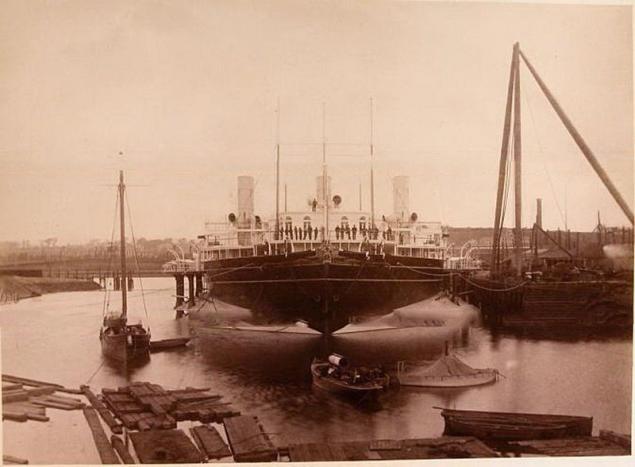
"Livadia", launched in quite a high degree of readiness, with superstructures and rudder-propeller system, was so original appearance, that the British "Times", traditionally does not fit on the pages of drawings, even domestic ships, made an exception for the yacht. This twin-ship newspapermen figuratively described as "a bull in the halibut." Indeed, the actual yacht (upper body), represented truncated at the waterline length of 79 to 25 m and a width of 33, 53 m installed on semisubmerged in water pontoon (lower casing), which had in terms of an elliptical shape, a length of 71 and 63 m and a maximum width of 46, 63 m. Its height amidships does not exceed 5, 49 m, the bottom was flat, with three keels: the average in the center line and aircraft, each of which is defended by an average of 5, 49 m. According to EE Gulyaev "... the yacht could be longer ... and has to satisfy the taste of the majority ...", but this would result in the need to increase capacity and reduce machine stability. Small designer sediment was determined as "outstanding feature" can reduce wave drag, which courts have broad, such as Novgorod, at high speeds, by definition, Froude, was the most significant. Hence it is clear that the construction of the two parts of the packages has been applied strictly out of a desire to reduce the possible draft boats to achieve the desired speed. As such, the design features a compound called "Livadia" really proves the complete original ideas of its creators.
Imperial yacht "Livadia" on the stocks
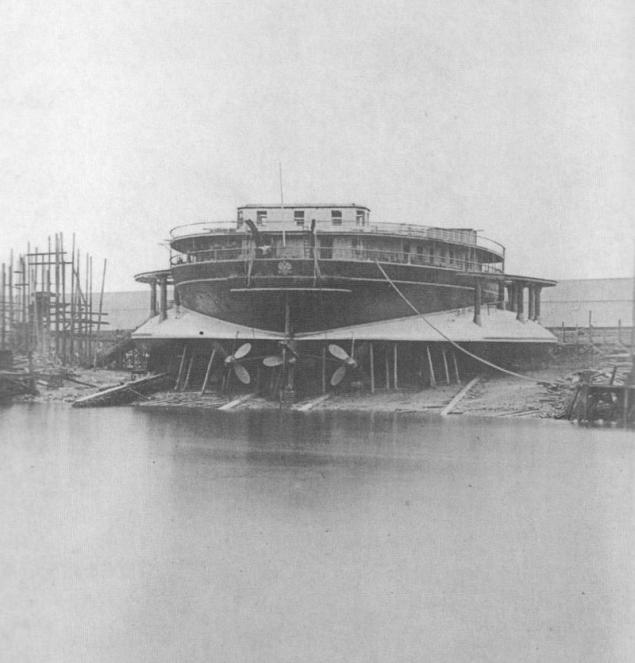
The design of the lower hull (the sailors called it "pancake") was unique. Designed based on the experience of building Novgorod, it provides unprecedented for that time, the level of flooding. On the entire length of the extended second bottom spaced from the casing to a height of 1, 07 m amidships and 0, 76 m in the extremities and divided into 40 watertight compartments; along the side were two vertical longitudinal bulkheads, the space between them and the board is also divided by transverse bulkheads into 40 departments. Laid convex, in the form of an inverted saucer, the pontoon deck provides a solid basis for the ring-shaped top of the boat, where all the living quarters and the royal apartments and the second floor -fundamentom three vertical steam engines, double steam expansion project with capacity of 3500 liters. from. each and 10 cylindrical boilers. The pontoon fit and coal pits and auxiliary machinery and marine stocks ...
Imperial screw yacht "Livadia" after launching

Considerable difficulties had to be overcome in the determination of total and local strength steel structure pontoon and the junction casings (annular stringer) that, in turn, has given rise to technical problems of their maintenance. To the credit of Russian and British engineers, these difficulties have been mostly overcome. The whole set is made of soft "simensonovskoy" steel cladding pontoon and bulkheads - from iron sheets; Deck & Cabin own yacht - pine. The total height from the keel to the top of the roof superstructure is 14 m. The Q & A driving force paid special attention. During the construction, by the end of 1879 and collected until the following spring steel we have experienced a self-propelled model of the yacht at 1:10, which worked out the location of the screws and size of their pitch. Tiedemann has developed test procedures and tests were conducted and the Russian and British engineers. As a result of lower unit boat shafts deduced so that most of its screw diameter was below the bottom, with the middle screw, as Vice-Admiral Popov, placed at 0, 76 m from the stern, and more deeply than the side. The diameter of each four-bladed propeller was 4, 72 m, the average step - 3, 81 m, the rest - 6, 25 meters; material served as manganese bronze.
Imperial yacht "Livadia" in Naples. May 1881

The premises were illuminated by electric 'candles Yablochkov "; All electrical equipment supplied from Russia. There was water all over the boat and 23 auxiliary steam mechanism, including the drive wheel. On the bridge, similar to the Popovka, put the device to maneuver the direction of movement of the ship with the help of on-board vehicles. As an offshore boats Yacht England ordered 3 large steam boat mahogany length, respectively, 11, 9, 9, 8, 8, 5 m. Rowing court used the old, with the first "Livadia". The total volume of the cabins, salons and halls destined for the king and the retinue, was 3950 m 3 - 6, 7 times higher than the that of the dead on a yacht. A huge "reception" of the emperor, about 4 meters high, reminiscent of Louis XVI room at Fontainebleau; there is a working fountain surrounded by flower bed ... The living room on the middle deck was furnished in the spirit of the Crimean Tatar, other rooms were decorated in a modern English style. Finishing cabins officers and command facilities in the contracts was not included and had to be carried out after the arrival of the ship in the Black Sea.
General view of the boat at the pier Livadia
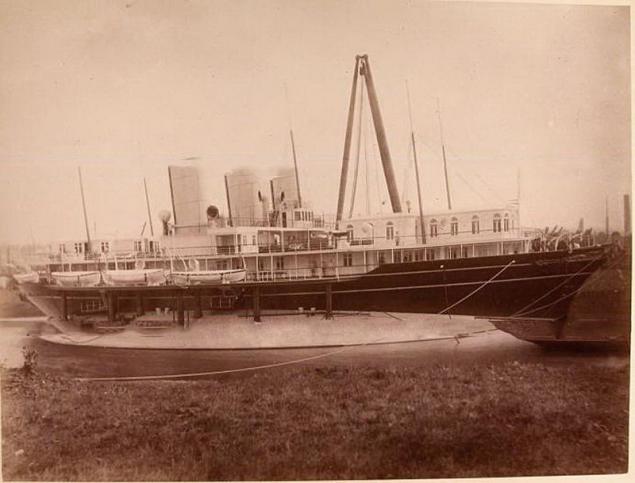
Despite the "absolutely original design," apparently the ship looked great, sleek body covered with shiny black lacquer and light gray pontoon almost merged with the water surface.
It took almost three months for the completion of the yacht afloat. In August, we loaded all boilers (8 trehtopochnyh identical boilers installed across the pontoon and two polukotla - them on the sides), and in early September - and the main cars, which are already 10 to 19 of the same month tried to mooring. In these studies involved due to the summer in England, an experienced mechanical engineer fleet - Major-General AI Sokolov and I. Zarubin.
September 24 "Livadia", led by the builder of the pier and the factory team, left the yard and pool under the middle car went down the river in Greenock; just in case it scored three tugs. The same day, the yacht went into the Gulf, easily reaching 12 knots of speed.
General view of the dining room


Tiedemann Chief Consultant noted that the ship stayed well on course and obey the helm as the boat. The next day, a factory test. On the ship we invited some Russian officers and 12 sailors from the yacht assigned to the team. According to AI Sokolov managed to develop a speed of 15 knots, with a headwind!
Corner living

26th Pierce invited on board of the Ministry of Maritime Commission under the chairmanship of Vice-Admiral JF Likhachev the official six-hour test. "Livadia" showed an average speed of 14, 88 kt. at capacity 10200l. from.; machines, due to the difference of pitch, to work with different speed: the average 90, 84 of the onboard rev / min. The same Tiedemann noticed that the work of all three machines radius of gyration "somewhat too big", but admitted it is not essential, as it was possible reversals "in a much smaller space," with the side screws - as Popovka. September 27 yacht experienced a measured mile: the average data of six runs its highest speed was found to be 15, 725 kt., And the capacity of the power plant - 12 354 liters. from. And this despite the fact that the ship's hull during the completion of a few overgrown and sat deeper than anticipated, due to more severe than in the calculations, the superstructure and interior. Draft has reached 2, 1 m and a displacement of -4420 m.
Boudoir table in one of the rooms

Calculations and experiments brilliantly confirmed. Everyone was happy. The company received a 2, 7 mln., Including 414 thousand. Rubles premiums. About the AA Popov EV Gulyaev written in all European newspapers.
Upon completion of testing the boat passed the Russian team, which arrived in August from the Baltic Fleet (which exceeded the state and has 24 officers and 321 NCO). September 30 yacht taken from the plant and on the same day, raising the flag and pennant jack, she started a campaign.
Corner of one of the living rooms (smoking),

Driving on the Black Sea was planned and as an educational voyage, "with only the development of power machines" - reported in August A. Popov - "to enable all personnel of the machine easy to look around and become familiar with the action and control of the car." After cooking, 3 October yacht left Grinoksky raid. On board, guests of honor, were shipbuilders Pierce, Tiedemann and Reed, as well as the controller of the British fleet, Admiral Steward. In Brest, climbed aboard the Grand Duke Konstantin Nikolaevich and, under the general admiral's flag, "Livadia" October 7 went on, through the Bay of Biscay in Cadiz.
View of the office

Until midnight October 8th march took place in favorable conditions, at a speed of 12-13 knots. Having risen rapidly during the night the wind got stronger, spreading a strong oncoming swell. From two o'clock in the morning on October 9 waves started to hit in the nose of a pontoon boat - first rare, these attacks with increasing wind and wave height increased. The course had to be reduced to 4-5 knots. But the strike did not stop. Quite restrained in their assessments Reid wrote: "The crash of the waves in a flat bottom boats were awful at times ..." The same was reported in the report and IK Vogak: "... one of them was particularly strong, performing the all mark as from hitting a solid object ... "At 10 am, we found that the first branch of the double bottom is filled with water; immediately had to change course and head to the Spanish port of Ferrol.
According to eyewitnesses, the wave heights of 6-7 m, with the rolling does not exceed 3, 5 ° on board, and keel - 9 ° span 5, 5 ° in the nose, and 3, 5 ° aft. Screws never denude. "The yacht did not fall," - reported to the commander: tableware and tall candelabra remained motionless in calm or soup plates or water glasses never leaked.
View of one of the bedrooms
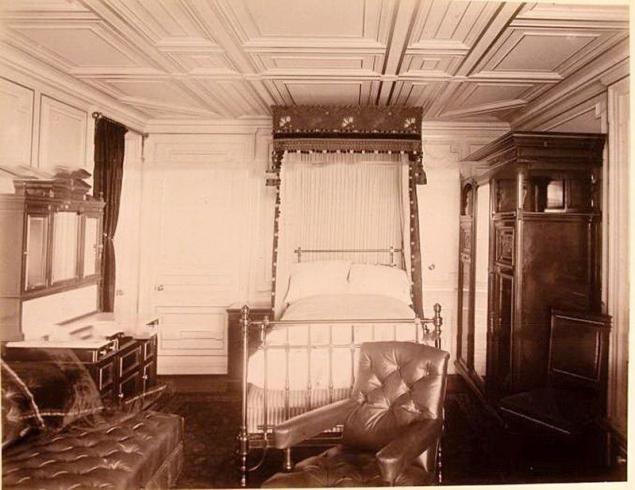
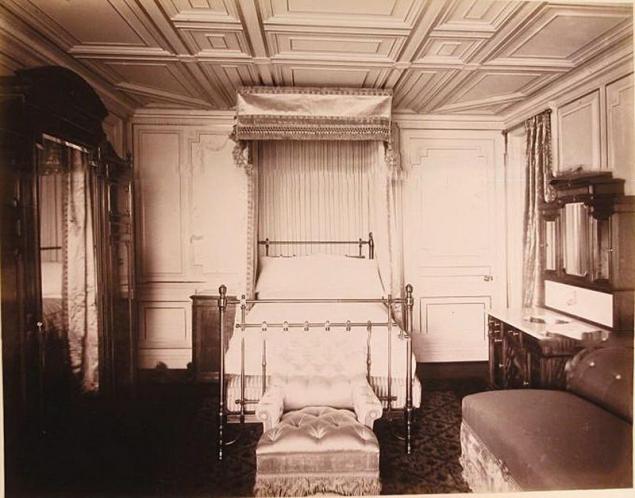
How does the "Livadia", led by an experienced sailor, fell into the center of the storm, and even went against the waves?
Source: humus.livejournal.com
Its construction began in late 1869, but the official laying of the ship took place March 19, 1870.

Design and build a boat the famous Black Sea naval captain of the Corps of Naval Architects LG Swedes, for completion by the summer of 1873. The new 4-wheel gun wooden boat on the king of comfort and decoration of the premises it is not inferior to the Baltic "Power", and on registration "royal cabin" in the stern of the boat, and the dining room on the middle deck, the implementation of the project of architect Monighetti even superior to the latter. In the course of construction "Livadia" LG Schwede in 1872 he performed the alleged figure figurehead yachts in the form of a convex oval shield with the double-headed eagle "Livadia" received a figurehead in the form of a two-headed eagle, crowned, like set to "Power".
In the summer of 1873 a new boat, entering the Black Sea Fleet, arrived in Sevastopol, where the empress brought to Yalta with his family. In March 1874 "Livadia" went to practice diving. In the western part of the Mediterranean yacht successfully withstood an 11-point storm, showing excellent seaworthiness. It should be noted that the "Livadia" - the only one of the imperial yacht, participated in combat operations of the Russian fleet. During the Russian-Turkish war of 1877-1878 under the command of Captain 1st Rank FE Krouna it cruising the Romanian and Bulgarian coast and 21 August sank two-masted Turkish kochermu. Noted two Turkish armored ships, yacht sustained 18-hour chase and successfully went under the protection of Sevastopol batteries. The three-year service "Livadia" ended tragically. On the way from Sevastopol to Odessa it is foggy night from 21 to 22 October 1878 jumped to the reef at Tar-hankutskogo lighthouse on the west coast of the Crimea. 47 days, from October 22 to December 7, "Livadia" standing on a rock. After a series of unsuccessful attempts to save the Black Sea Fleet command ship, everything of value that was possible, had been brought to shore, leaving the body waves of the sea.
It was supposed to build a new, similar victims, increasing its speed and cruising range, but Vice-Admiral AA Popov, at that time, and became chairman of the MTC, he proposed another option. According to the instructions of EE Gulyaev drafted a yacht, having regard to the shape of an ellipse on the basis of Novgorod. Considering this form the starting point for selecting the type of the future of the Black Sea battleship, Andrey decided on a full-scale experiment. It is understood by those skilled not only in Russia but also in England. Thus, the "Times" in 1879 wrote: "... the stability and comfort are the main qualities that were pursued in the design of the yacht, and if the maximum stability is provided in the form of the famous yacht, the addition of armor and possible changes can make it on the basis of the same principle, not less stable artillery platforms. It is no secret that the new yacht has experience ... ».
In addition to providing stability, comfort and safety of navigation, the main attention was paid to the design of the achievement of a new vessel speed of 14 knots. According to the results of tests on Vice Admiral Popov in the Black Sea and the model tests in England to identify the main dimensions of the future yachts with draft 1, 9 m, satisfying all the requirements proposed. To check the data, and at the request of designers and builders of the future, paraffin models her body underwent at the beginning of 1879 a new test in Amsterdam under the guidance of Tiedemann. This very well-known shipbuilder and the chief engineer of the Dutch navy confirmed the conclusions of the Froude and guarantee the achievement of a vessel speed of 14 kt, when the power of the power plant more than 8,500 liters. from. (project capacity was assumed to be l 10000-11000. sec.). The general location of the royal screw yacht "Livadia»

At mid-year, as agreed with the British shipbuilding company "John Elder and K °», the project finalization. In August, after a written statement of the main builder of the firm Pierce the possible establishment of such a vessel, followed by a private resolution of Alexander II to build a new yacht in England. September 5 Pier and the famous Russian figure shipbuilding MI Qazi signed. The terms of this document was not very common. Their essence was to shipbuilders obligation not only to build itself on the Russian ship's drawings, with the installation of its own production of steam mechanisms, but also the guarantee of achieving boat speed of 15 knots. For each undeveloped 0, 1 assembly firm paid heavy fines, and in the case if the ship goes at a speed less than 14 kt., The customer has the right to do, it does not take, and pick up only power plant, for which, and pledged to make the contractual payments in the buildings. If successful, the test calculation of the yacht followed after her surrender. For exceeding speed limits (15 kt.) And capacity (12,000 liters. With.) Builders received substantial bonuses. The latter condition was to encourage firms to create and perfect power plants, intended not only for yachts, but also, if successful, for future Russian ships and the battleship Peter the Great, the machine is, as well, and have a series of Novgorod did not develop capacity. < br />
The period of construction was in English is short: until 1 July next, 1880 Furthermore, during a personal audience with the Grand Duke Konstantin Nikolayevich after signing the contract, Pierce offered early surrender yacht! The work at the shipyard, located in Ferrol (on the River Clyde, on the outskirts of Glasgow), began immediately after the signing of the documents. Appointed oversaw the construction, the author of EE Gulyaev a month later reported on the manufacture of templates for metal structures and complete the preparation of the stacker places. By early November, two-thirds of the bottom of the second set has riveted ... Next again intervened AA Popov, who achieved the highest resolution on the decoration of yacht in England, referring to "the desirability of testing the ship in final form" and the high cost of such work in the Nicholas Admiralty. November 10 entered into another contract: shipbuilders have received, except for an additional payment, a real opportunity to move, if necessary, the term readiness yacht. Nevertheless, work continued on the initial estimates.
January 5th, 1880 the yacht was enrolled in the lists of the fleet of ships called "Livadia", and 10 days received a Commander - Captain 1st Rank IK Vogak (former first commander and "Novgorod" and "Peter the Great") ... 25 March the official laying of the ship; at that time already mounted shell plating. Exactly four months - 25 June, the boat was lowered into the water. The ceremony was attended by Grand Duke Alexei Alexandrovich (future General Admiral of the Russian fleet and consistent foe A. Popov).
The yacht is docked in Livadia

"Livadia", launched in quite a high degree of readiness, with superstructures and rudder-propeller system, was so original appearance, that the British "Times", traditionally does not fit on the pages of drawings, even domestic ships, made an exception for the yacht. This twin-ship newspapermen figuratively described as "a bull in the halibut." Indeed, the actual yacht (upper body), represented truncated at the waterline length of 79 to 25 m and a width of 33, 53 m installed on semisubmerged in water pontoon (lower casing), which had in terms of an elliptical shape, a length of 71 and 63 m and a maximum width of 46, 63 m. Its height amidships does not exceed 5, 49 m, the bottom was flat, with three keels: the average in the center line and aircraft, each of which is defended by an average of 5, 49 m. According to EE Gulyaev "... the yacht could be longer ... and has to satisfy the taste of the majority ...", but this would result in the need to increase capacity and reduce machine stability. Small designer sediment was determined as "outstanding feature" can reduce wave drag, which courts have broad, such as Novgorod, at high speeds, by definition, Froude, was the most significant. Hence it is clear that the construction of the two parts of the packages has been applied strictly out of a desire to reduce the possible draft boats to achieve the desired speed. As such, the design features a compound called "Livadia" really proves the complete original ideas of its creators.
Imperial yacht "Livadia" on the stocks

The design of the lower hull (the sailors called it "pancake") was unique. Designed based on the experience of building Novgorod, it provides unprecedented for that time, the level of flooding. On the entire length of the extended second bottom spaced from the casing to a height of 1, 07 m amidships and 0, 76 m in the extremities and divided into 40 watertight compartments; along the side were two vertical longitudinal bulkheads, the space between them and the board is also divided by transverse bulkheads into 40 departments. Laid convex, in the form of an inverted saucer, the pontoon deck provides a solid basis for the ring-shaped top of the boat, where all the living quarters and the royal apartments and the second floor -fundamentom three vertical steam engines, double steam expansion project with capacity of 3500 liters. from. each and 10 cylindrical boilers. The pontoon fit and coal pits and auxiliary machinery and marine stocks ...
Imperial screw yacht "Livadia" after launching

Considerable difficulties had to be overcome in the determination of total and local strength steel structure pontoon and the junction casings (annular stringer) that, in turn, has given rise to technical problems of their maintenance. To the credit of Russian and British engineers, these difficulties have been mostly overcome. The whole set is made of soft "simensonovskoy" steel cladding pontoon and bulkheads - from iron sheets; Deck & Cabin own yacht - pine. The total height from the keel to the top of the roof superstructure is 14 m. The Q & A driving force paid special attention. During the construction, by the end of 1879 and collected until the following spring steel we have experienced a self-propelled model of the yacht at 1:10, which worked out the location of the screws and size of their pitch. Tiedemann has developed test procedures and tests were conducted and the Russian and British engineers. As a result of lower unit boat shafts deduced so that most of its screw diameter was below the bottom, with the middle screw, as Vice-Admiral Popov, placed at 0, 76 m from the stern, and more deeply than the side. The diameter of each four-bladed propeller was 4, 72 m, the average step - 3, 81 m, the rest - 6, 25 meters; material served as manganese bronze.
Imperial yacht "Livadia" in Naples. May 1881

The premises were illuminated by electric 'candles Yablochkov "; All electrical equipment supplied from Russia. There was water all over the boat and 23 auxiliary steam mechanism, including the drive wheel. On the bridge, similar to the Popovka, put the device to maneuver the direction of movement of the ship with the help of on-board vehicles. As an offshore boats Yacht England ordered 3 large steam boat mahogany length, respectively, 11, 9, 9, 8, 8, 5 m. Rowing court used the old, with the first "Livadia". The total volume of the cabins, salons and halls destined for the king and the retinue, was 3950 m 3 - 6, 7 times higher than the that of the dead on a yacht. A huge "reception" of the emperor, about 4 meters high, reminiscent of Louis XVI room at Fontainebleau; there is a working fountain surrounded by flower bed ... The living room on the middle deck was furnished in the spirit of the Crimean Tatar, other rooms were decorated in a modern English style. Finishing cabins officers and command facilities in the contracts was not included and had to be carried out after the arrival of the ship in the Black Sea.
General view of the boat at the pier Livadia

Despite the "absolutely original design," apparently the ship looked great, sleek body covered with shiny black lacquer and light gray pontoon almost merged with the water surface.
It took almost three months for the completion of the yacht afloat. In August, we loaded all boilers (8 trehtopochnyh identical boilers installed across the pontoon and two polukotla - them on the sides), and in early September - and the main cars, which are already 10 to 19 of the same month tried to mooring. In these studies involved due to the summer in England, an experienced mechanical engineer fleet - Major-General AI Sokolov and I. Zarubin.
September 24 "Livadia", led by the builder of the pier and the factory team, left the yard and pool under the middle car went down the river in Greenock; just in case it scored three tugs. The same day, the yacht went into the Gulf, easily reaching 12 knots of speed.
General view of the dining room


Tiedemann Chief Consultant noted that the ship stayed well on course and obey the helm as the boat. The next day, a factory test. On the ship we invited some Russian officers and 12 sailors from the yacht assigned to the team. According to AI Sokolov managed to develop a speed of 15 knots, with a headwind!
Corner living

26th Pierce invited on board of the Ministry of Maritime Commission under the chairmanship of Vice-Admiral JF Likhachev the official six-hour test. "Livadia" showed an average speed of 14, 88 kt. at capacity 10200l. from.; machines, due to the difference of pitch, to work with different speed: the average 90, 84 of the onboard rev / min. The same Tiedemann noticed that the work of all three machines radius of gyration "somewhat too big", but admitted it is not essential, as it was possible reversals "in a much smaller space," with the side screws - as Popovka. September 27 yacht experienced a measured mile: the average data of six runs its highest speed was found to be 15, 725 kt., And the capacity of the power plant - 12 354 liters. from. And this despite the fact that the ship's hull during the completion of a few overgrown and sat deeper than anticipated, due to more severe than in the calculations, the superstructure and interior. Draft has reached 2, 1 m and a displacement of -4420 m.
Boudoir table in one of the rooms

Calculations and experiments brilliantly confirmed. Everyone was happy. The company received a 2, 7 mln., Including 414 thousand. Rubles premiums. About the AA Popov EV Gulyaev written in all European newspapers.
Upon completion of testing the boat passed the Russian team, which arrived in August from the Baltic Fleet (which exceeded the state and has 24 officers and 321 NCO). September 30 yacht taken from the plant and on the same day, raising the flag and pennant jack, she started a campaign.
Corner of one of the living rooms (smoking),

Driving on the Black Sea was planned and as an educational voyage, "with only the development of power machines" - reported in August A. Popov - "to enable all personnel of the machine easy to look around and become familiar with the action and control of the car." After cooking, 3 October yacht left Grinoksky raid. On board, guests of honor, were shipbuilders Pierce, Tiedemann and Reed, as well as the controller of the British fleet, Admiral Steward. In Brest, climbed aboard the Grand Duke Konstantin Nikolaevich and, under the general admiral's flag, "Livadia" October 7 went on, through the Bay of Biscay in Cadiz.
View of the office

Until midnight October 8th march took place in favorable conditions, at a speed of 12-13 knots. Having risen rapidly during the night the wind got stronger, spreading a strong oncoming swell. From two o'clock in the morning on October 9 waves started to hit in the nose of a pontoon boat - first rare, these attacks with increasing wind and wave height increased. The course had to be reduced to 4-5 knots. But the strike did not stop. Quite restrained in their assessments Reid wrote: "The crash of the waves in a flat bottom boats were awful at times ..." The same was reported in the report and IK Vogak: "... one of them was particularly strong, performing the all mark as from hitting a solid object ... "At 10 am, we found that the first branch of the double bottom is filled with water; immediately had to change course and head to the Spanish port of Ferrol.
According to eyewitnesses, the wave heights of 6-7 m, with the rolling does not exceed 3, 5 ° on board, and keel - 9 ° span 5, 5 ° in the nose, and 3, 5 ° aft. Screws never denude. "The yacht did not fall," - reported to the commander: tableware and tall candelabra remained motionless in calm or soup plates or water glasses never leaked.
View of one of the bedrooms


How does the "Livadia", led by an experienced sailor, fell into the center of the storm, and even went against the waves?
Source: humus.livejournal.com







